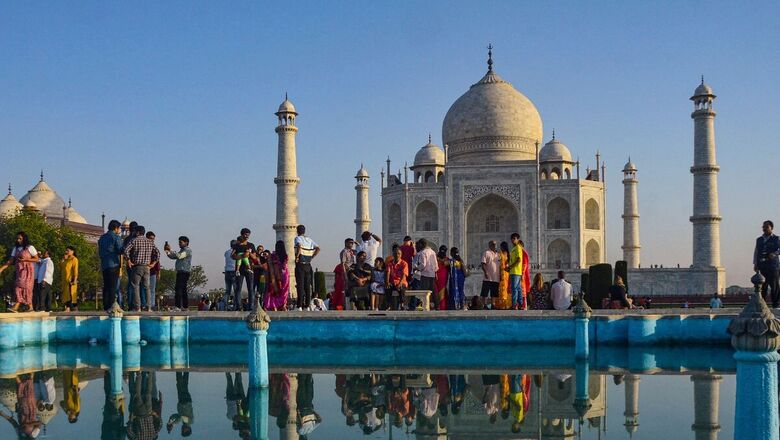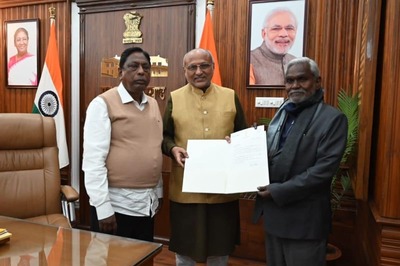
views
The US has emerged as the top contributor of foreign tourists to India for the second year running, with Bangladesh, the United Kingdom, Australia and Canada following respectively in the top five for 2022.
A little over 61.19 lakh foreign tourists visited India in 2022, a growth of 305.4% over the same January-December period in 2021. In 2019, a record 10.93 million foreign tourists had arrived in India, the highest number before Covid-19 brought global travel to a grinding halt in 2020.
The Union Tourism Ministry’s statistics are based on provisional data provided by the Bureau of Immigration, which reveals that just three countries – the US, Bangladesh and the UK – constituted over 50% of Foreign Tourist Arrivals (FTAs) in India during the previous year.
A total of 13,73,817 tourists, accounting for 22.19% of the FTAs, originated from the US. Bangladesh followed closely with 12,55,960 visitors, representing 20.29% of the FTAs. The UK contributed 6,17,768 tourists, constituting 9.98% of the total arrivals.

Australia and Canada secured the fourth and fifth positions, contributing 5.96% and 4.48%, respectively to the FTAs. Sri Lanka, Nepal, Germany, Singapore, and Malaysia ranked from sixth to 10th. Overall, these 10 nations collectively contributed approximately 74% of the total FTAs in 2022.
In 2021, the US reclaimed its position as the leading source of foreign tourists to India, marking a return to the top spot after five years during which Bangladesh topped the charts.
However, data for the first six months of the current calendar year shows Bangladesh once again surpassing the US to reclaim the top spot. Between January and June this year, India’s neighbour holds a 23.5% share, followed by the US (18.1%) and the UK (9.2%).
Experts attribute Bangladesh’s ascendancy on India’s tourism landscape to the lack of consulates for several European nations. Consequently, citizens of Bangladesh are compelled to journey to India for visa processing. Additionally, a significant number of Bangladeshis seek medical treatment in India, further adding up to their travel numbers.
Except for Bhutanese and Nepalese citizens directly traveling to India, all foreign nationals, including children, need a visa to travel to India.
In 2013, the US was followed by the UK, Bangladesh, Sri Lanka, and Russia as the top FTA sources. A decade earlier, in 2003, the UK topped the charts, while the US came second, followed by Sri Lanka, Canada, and France, respectively.
Any change in the FTA landscape of a country also reflects the state of the host country’s diplomatic relationship with the tourist-sending nation, in addition to people-to-people contacts and business relationships.
In terms of the timing of foreign guest arrivals, the month of December is the peak time when overseas tourists prefer to explore India. However, according to the data, January has been observed as a quieter month on the country’s tourism calendar.
According to provisional estimates, the country’s foreign exchange earnings from tourism witnessed a remarkable 92.4% increase, reaching US$ 16.93 billion in 2022, compared to just US$ 8.8 billion in 2021. However, the earnings for 2022 still remain 45% below the 2019 earnings of US$ 30.72 billion.
Among the preferred entry routes for foreign tourist arrivals into India, Delhi airport held the top position with a 31.21% share. Mumbai airport came in second with a 14.70% share, followed by the land border check post at Haridaspur in West Bengal at number three with a 9.47% share. Located around 200km northeast of Kolkata, this is the main point through which Bangladeshi citizens cross over to the Indian side.
Chennai and Bangalore airports held the fourth and fifth positions, respectively, with a share of 9.24% and 6.36% of FTAs.
Prime Minister Narendra Modi’s home state Gujarat was the top choice for foreign tourists last year, with 1.78 million (20.70%) visiting the western state. Gujarat is famous for attractions such as Gir National Park, the Statue of Unity, Dwarka, the Shri Somnath Temple, the Rann of Kutch, and numerous festivals, including the renowned International Kite Festival, Navaratri Kankaria Carnival, Navaratri celebrations, and Kutch Rannotsav.
According to National Crime Records Bureau (NCRB) data, the state has also been safer for foreign tourists. In 2021, the latest year for which state-wise comparable data is available, only one case of crime against foreigners was reported, with a 100% charge-sheeting rate. In comparison, the national capital Delhi registered 27 cases, while Tamil Nadu had 16. Kerala and Telangana each reported 15 cases in 2021, as per the NCRB record.
Maharashtra, with estimated 1.51 million (17.60%) FTAs, came second, while West Bengal (12.08%), Delhi (9.50%), and Uttar Pradesh (7.56%) ranked as the third, fourth, and fifth states to host foreign guests last year.
In 2021, Punjab had the highest number of FTAs (29.2%), followed by Maharashtra, Delhi, Karnataka, and Kerala, respectively.
During the last financial year until February, Agra’s Taj Mahal, with 3.28 lakh foreign footfall, reclaimed the top position among the list of most-visited centrally protected ticketed ASI monuments. In the previous fiscal year, monuments in Mamallapuram, a Tamil Nadu town classified as a UNESCO World Heritage site, had surpassed the Taj Mahal in terms of the number of foreign visitors.
While the quoted FTA and foreign exchange numbers above may seem impressive in isolation, the actual scenario reveals that India has been underperforming on a global scale. Despite boasting of a diverse, rich, and vibrant cultural landscape, along with a wealth of historical heritage and a variety of ecologies, terrains, and natural beauty spots, India has not achieved significant success in attracting foreign tourists.
According to records from the United Nations World Tourism Organization (UNWTO), India’s share of the global total tourist arrivals was a mere 2% in 2021, and the country ranked 14th with just a 1.64% share in international tourism receipts. This is not an encouraging sign for the world’s most populous nation.
On the World Economic Forum’s Travel and Tourism Development Index 2021, India ranked 54th (down from 34th in 2019).
Efforts are indeed being made to fully leverage India’s tourism potential. Theme-based tourism circuits, such as wellness tourism, culinary tourism, rural and eco-tourism, among others, are being actively promoted. The e-Visa system has been further liberalised, accompanied by a substantial reduction in visa fee. Measures are being taken to enhance law and order, while the GST on hotels has been lowered to enhance India’s competitiveness.
A significant number of tourism sites and facilities are undergoing upgrades to meet international standards. The country’s connectivity has improved considerably, thanks to RCS Udan. A 24×7 toll-free Multi-Lingual Tourist Helpline is now available to assist tourists.
India has the potential to excel in wellness tourism, given its competitive advantage of affordable tertiary healthcare combined with a commendable standard of medical services. In addition to contributing to foreign exchange earnings, the tourism sector significantly fuels employment, holding a substantial 12.66% share of jobs in India during 2021-22.



















Comments
0 comment